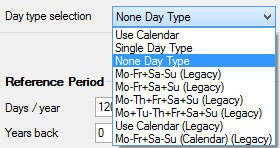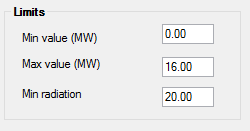
The Helios 2.0 models are intended for solar energy forecasts. For the reference period, which is the number of days selected symmetrically around the forecast start date 1, 2 etc. years back, the hours of the day for which production is always zero are determined. Then the weather dependency during the base period is estimated. For Helios 2.0 – A (Aiolos), the base period is one year back from the forecast start, lying symmetrically around the forecast start date, and for Helios 2.0 – C (Cilia) immediately prior to the forecast start. If the series is a pure solar production series, the day type selection option “None Day Type” should be selected.

Unlike the calendar-dependent options, where the regression attempts to explain differences in load by differences in weather, here a weather-dependency is estimated and represented in absolute values. If the series contains hidden ‘day type’-dependent consumption, you have two alternatives. The first is that you let the adaption distinguish between weekends and weekdays (and you can select the same period for the adaption as for the base period). The program will in that case first estimate a weather dependency for all days. Then, based on the second choice selection option in the calendar, the adaption will adjust the weather dependency based on weekends/weekdays. The other alternative way of allowing for day type dependency is to select an option other than “None Day Type” in the calendar settings.

The model then switches to estimating the weather dependency in the form of differences between the day type pattern and corresponding values during the base period.
You can also explicitly specify a radiation threshold, ’Min radiation’ , so that for solar radiation values lower than the threshold, the production forecast will be zero.
